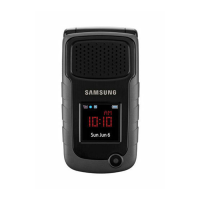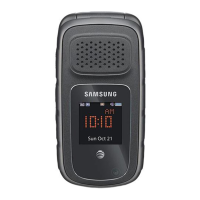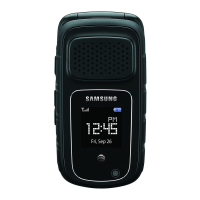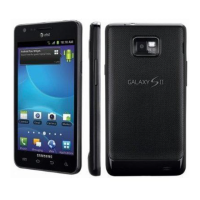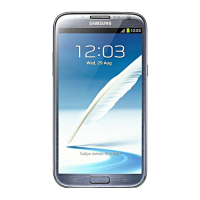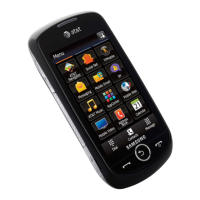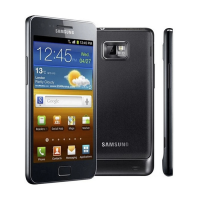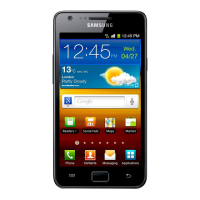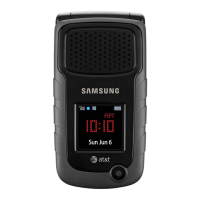
Do you have a question about the Samsung Rugby II SGH-A847 and is the answer not in the manual?
| Network Technology | GSM / HSPA |
|---|---|
| 2G bands | GSM 850 / 900 / 1800 / 1900 |
| 3G bands | HSDPA 850 / 1900 |
| GPRS | Class 10 |
| EDGE | Class 10 |
| Status | Discontinued |
| SIM | Mini-SIM |
| Type | TFT, 256K colors |
| Call records | Yes |
| Video | Yes |
| Loudspeaker | Yes |
| 3.5mm jack | No |
| WLAN | No |
| Bluetooth | 2.1, A2DP |
| GPS | No |
| Messaging | SMS, MMS, Email |
| Browser | WAP 2.0/xHTML |
| Games | Yes |
| Java | Yes, MIDP 2.0 |
| Colors | Black |
| Operating System | Feature phone |
| Speed | HSPA 3.6 Mbps |
| Size | 2.2 inches |
| Resolution | 240 x 320 pixels |
| Memory Card slot | microSD |
| Phonebook | 1000 entries |
| Alert types | Vibration, MP3 ringtones |
| Radio | FM radio |
| USB | 2.0 |
| Features | Organizer |
| Battery | Li-Ion 1300 mAh |
| Other Features | dust, shock, vibration, temperature, rain, salt mist |
Details about the SIM card received with the 3G cellular network service.
Steps required for phone activation: SIM card insertion, battery charging, and powering on.
Instructions and diagrams for opening the battery cover and removing the battery.
Important notes and steps for inserting and removing the SIM card, emphasizing caution.
Instructions for inserting a microSD card for additional memory, including supported sizes.
Step-by-step guide for reinstalling the battery and closing the phone cover, including waterproofing notes.
Instructions for charging the phone's Li-ion battery using the travel adapter and approved chargers.
Explains the indicators and warnings for a weak battery and low power.
Steps to power the phone on and off, including password entry and network search.
Instructions for setting up personal voicemail options and changing the voicemail number.
Lists various features included in the phone, such as PTT, Mobile Web, Bluetooth, Camera, etc.
Illustrations showing the main elements of the phone when open, with numbered key components.
Correlates front view illustrations of the phone keys with their functions.
Illustrations showing the main elements of the phone when closed, with numbered key components.
Correlates side view illustrations of the phone keys with their functions.
Explains the function of the back light for the display and keypad.
Describes the four areas of the main display: Icons, Date/Time, Text/Graphic Area, Soft Key Indicators.
Explains various icons displayed on the phone, such as signal strength, battery level, network access, call status, etc.
How menus and sub-menus are accessed using navigation keys or shortcut keys.
Details on accessing applications from Idle mode using shortcuts.
How to view and select functions and options within menus.
Defines functions for soft keys and the clear key.
Explains the functions of the End key for calls, powering on/off, and menu navigation.
Explains the functions of the Send key for answering, dialing, and accessing call logs.
Describes how to use navigation keys for menus, lists, and launching applications.
Steps to make a standard call by entering a number.
Steps to make an international call using the '+' character.
Procedures to correct mis-typed entries while dialing.
How to end an active call by pressing the End key or closing the phone.
How to dial numbers with pauses for automated systems.
How to display and call the last dialed number.
Accessing and dialing numbers from the Recent Calls menu.
How to store and dial numbers using the Address Book and Speed Dial.
Steps to answer an incoming call, including options like Any Key and Open Flip.
Information about initiating and receiving video share sessions.
Steps to start and accept a video share session.
Accessing and viewing lists of incoming, outgoing, and missed calls.
Options for viewing details and performing actions on call entries.
How to view details of missed calls.
Steps to save a missed call entry into the Address Book.
How to send a message to a missed call entry.
Steps to delete missed call entries.
How to view detailed information about specific calls.
How to call back a missed call number.
Control functions available during an active call.
How to adjust the ear piece and ringer volume.
Procedures to place a call on hold and make another call.
Accessing options like Speaker on/off, Video Share, Hold, Address Book, Noise Reduction.
How to temporarily turn off the microphone.
How to search for a contact in the Address Book during a call.
Notifies of incoming calls during an active call.
Feature to answer multiple incoming calls and join them.
How to activate silent mode for quiet environments.
Overview of available text input methods: ABC, T9, Numeric, Symbols.
How to enter text using the alphabetic input method.
How to enter words using the T9 predictive text system.
How to enter numbers.
How to enter symbols and punctuation.
Steps to change the text input mode from various options.
Detailed steps for entering words using the T9 predictive text method.
How to add custom words to the T9 dictionary.
Detailed steps for entering text using the alphabetic input method.
How to enter symbols and punctuation using the Symbols input method.
How to enter numbers using the Numeric input method.
Steps to initialize the PTT service, including entering a PTT name.
Covers icons indicating availability status for individuals and groups in PTT Contacts.
How your availability status is displayed to others in PTT Contacts.
Explains icons for individual availability: Available, Unavailable, Do Not Disturb, PTT Message.
Explains icons for group availability: Group Available, Group Unavailable, Group Do Not Disturb, Group Available/Silent or Vibrate, Group Invitation in Progress.
Steps to add contacts to PTT Contacts list.
How to access and view the PTT Contacts list.
Options available for PTT contacts like Call Me Alert, Quick Group, Voice Message, Send Message, View, Add Group, Add Contact, Edit, Delete, Save to Address Book.
Options for managing PTT groups like View Group, Voice Message, Add Group, Edit, Delete.
Steps to delete PTT contacts from the list.
How the group creator can delete a PTT group.
How to make a PTT call to individuals or groups.
Steps to name and create a new PTT group.
How to add existing PTT contacts or new contacts to a group.
How to remove members from a PTT group.
Steps for the group creator to delete a group.
How to initiate a PTT call by pressing and holding the PTT key.
How to receive PTT calls based on availability status (Available, Vibrate All, Silent).
Options available during a PTT call: Convert to Cellular, PTT Contacts, New Call, Hold, Send Message, End Call.
Steps to convert an ongoing PTT call to a cellular call.
How to access and configure PTT settings.
Details on My Availability, Contact Alerts, Set Your Name, Auto Accept Invites, PTT is ON, Sort Options.
Displays unanswered contact list invitations that can be accepted or rejected.
Notification of incoming PTT or cellular calls during an active PTT or cellular call.
Provides brief descriptions for various help topics related to PTT.
Steps to activate the AT&T Address Book for automatic contact synchronization.
Options to configure Address Book functions like My Business Card, Save New Contacts to, View Contacts from.
Procedure to store a new contact, including entering names, numbers, email, and group.
How to add additional fields to an existing contact entry.
How to delete specific fields from a contact number.
How to save a number from the Recent Calls screen to the Address Book.
How to add pauses to contact numbers for automated systems.
How to dial numbers from the Address Book using SIM location or search.
Storing and accessing phone numbers and names in the Address Book.
Options for calling, editing, sending messages, deleting, or marking default numbers for contacts.
How to synchronize phone Address Book with AT&T Address Book for backup.
How to check your own phone number.
Restricts outgoing calls to a limited set of numbers stored in the FDN list.
How to enable or disable the Fixed Dialing Number (FDN) mode.
Steps to add new numbers to the FDN list.
How to create and manage groups within the Address Book.
Steps to name and create a new PTT group.
How to add contacts to an existing group.
How to remove contacts from a group.
How to rename an existing group.
How to assign numbers to speed dial locations (2-9).
How to view and dial service numbers provided by the service provider.
Copying, deleting, and viewing memory status for Phone and SIM entries.
How to copy contact entries from the phone to the SIM card.
How to copy contact entries from the SIM card to the phone.
How to delete phone or SIM entries from the Address Book.
How to delete all entries from the SIM card.
How to view memory usage for Address Book entries on the phone and SIM card.
Accessing local businesses, maps, and events via the Yellowpages Mobile application.
Lists available message types: Text, Multimedia, and IM Messages.
Steps to create and send text messages using SMS.
How to send and receive multimedia messages, including attachments.
How to attach your business card to an outgoing message.
How to find and review received messages (text, multimedia, voicemail).
Where received messages are stored and how to identify message types.
Steps to view and retrieve text messages from the Inbox.
Steps to view and retrieve multimedia messages from the Inbox.
Options for SMS and Multimedia messages like Reply, Call, Delete, Forward, Save to Address Book, More.
Where sent and scheduled messages are stored.
Where unsent messages are stored for later editing.
Sending and receiving instant messages using AIM, Windows Live, Yahoo.
Initial sign-in procedure for IM accounts.
How to access and use mobile email services like Yahoo!, AOL, Gmail.
How to access voicemail.
Steps to access voicemail from the phone.
How to access voicemail from a different phone.
Options for configuring messaging services.
Option to automatically delete older messages based on age.
Available options for text messages: Delivery Options, Text Message Center, SMS Settings, Email Settings, Empty.
Available options for multimedia messages: Delivery Options, Priority, Expiration, Delivery Time, Message Size.
More options for multimedia messages like Get Delivery Report, Keep a Copy, Add My Business Card, Receiving Options, MMS Profiles, Auto Resize Image, Creation Mode, Default Style.
Option to specify the default phone number for remote voicemail access.
How to manage push message reception.
Receiving text messages on various topics like weather or traffic.
How to use and manage text and multimedia message templates.
Option to delete messages from specific folders or all folders.
How to view memory usage for different message types and categories.
How to shop for and purchase ringtones.
How to shop for and purchase games.
How to shop for and purchase graphic images.
How to shop for and purchase answer tones.
Accessing the MEdia Net homepage for quick access to information and shopping sites.
Options available from the AppCenter homepage like MEdia Mall Home, MyMEdia Club, MEdia Mall Account, My Answer Tones, Recently Viewed, Exit.
Accessing and shopping for various phone applications.
Accessing Tones, Answer Tones, Music, and Recorded Audio.
Playing pre-loaded games and shopping for games via AppCenter.
Steps to launch AppCenter and shop for games.
Accessing photos and videos stored off the phone using AT&T Mobile Share.
Accessing and using the Pictures folder.
Steps to open the Pictures folder and view photos.
Options available when selecting graphics, including Download, Take Photo, Create Folder.
How to shop for graphic images and wallpapers via AppCenter.
Access to various tools like Camera, Voice Recognition, Alarms, Calendar, Calculator, etc.
Instructions for using the camera to take photos.
Steps for taking photos, including aiming and using camera options.
How to take self-portraits using the Self Shot feature.
Explains icons for camera modes like Camera, Camcorder, Video Share Call, Shooting mode, Photo size.
Options available after taking a photo: Send, Set as, Delete, Rotate.
Accessing previously taken photos or videos via the View option.
Options for editing a photo, including Zoom, Send, Set as, Delete, Rename, Move, Copy, Create Folder, More.
Instructions for using the camcorder to shoot video.
Steps for shooting video, including capturing, stopping, saving, and previewing.
Explains icons for camcorder modes like Camcorder mode, Shooting mode, Video clip size, White Balance, Record Audio.
Options after shooting a video: Send via, Delete, Rename, Move, Copy, Create Folder, More.
Steps to access the Video folder to play video clips.
Using Nuance Voice Recognition software for voice commands.
Tips for using voice recognition effectively.
How the software automatically voice-activates contact names.
How to record voice memos and send them as MMS attachments.
Options for recording audio: Play, Record, My Voice Clips, Record Audio Settings, Send via, Set as, Delete, More.
How to access audio clips, including default tones and recorded audio.
Setting alarms, including wake-up alarms and auto power-up.
Steps to set a primary, secondary, third, or fourth alarm.
Various options for setting alarms: Name, Alarm Activation, Alarm Time, Alarm Type, Alarm Tone, Alarm Volume, Recurrence, Snooze, Repeat.
How to set alarms that ring even when the phone is switched off.
Viewing calendar layouts and creating event entries.
Steps to access the Calendar menu.
How to create an Appointment entry in the calendar.
How to create an Anniversary entry in the calendar.
Options for viewing, creating, sending, deleting, or saving calendar entries.
How to view details of selected calendar events and event categories.
How to create "to do" entries similar to calendar entries.
How to create notes to add to events.
Using the phone as a calculator for basic arithmetic.
How to use the phone to calculate tips based on bill amount, tip percentage, and number of people.
Accessing conversion menus for Currency, Length, Weight, Volume, Area, and Temperature.
Viewing the time in different cities and time zones worldwide.
Steps to add a new time zone to the World Clock.
How to edit an existing time zone in the World Clock.
How to set a countdown timer.
How to measure time intervals and record lap times.
How to shop for video files using AppCenter and download them.
How to view and manage files stored on the phone or memory card.
How to view memory usage on the phone and memory card.
Accessing pre-installed games and shopping for new games.
Steps to launch AppCenter and shop for games.
Accessing phone applications and shopping for new ones via AppCenter.
Steps to launch AppCenter and shop for new applications.
Steps to access the AT&T Music service.
Methods to add music files to the handset.
How to play music files using the Music Player application.
Options to configure music playback, shuffle, loop, playlists, shop music, equalizer, download status, properties.
How to play music files transferred to the phone or microSD card.
How to play music wirelessly via a stereo Bluetooth device.
How to play music in the background while using other phone features.
Steps to create a new playlist of preferred media.
How to add songs to an existing or new playlist.
How to remove songs from a playlist.
Steps to import playlists from Windows Media Player.
How to shop for ringtones, answer tones, and songs.
How to download music from a computer to the handset using a microSD card and USB cable.
How to transfer music using a media application like Windows Media Player.
Application to analyze music samples and identify songs.
How to stream commercial-free music channels.
How to access popular multimedia content, including music videos.
How to view video clips from the Favorites section.
Finding artist information, sound clips, wallpapers, and bios.
Accessing internet-based music tools and services.
How to shop for and purchase GPS applications.
Using the AT&T Navigator for driving directions and location-based services.
Locating family members and receiving location alerts.
Monitoring outdoor fitness activities like distance, speed, and calories.
Cellphone-based GPS sharing system for visualizing and connecting with users.
Finding places of interest, things to do, and local information using GPS.
Planning outdoor trips and using GPS for navigation and tracking.
Audible and visual driving aid using GPS navigation.
Managing time for small and medium enterprises using GPS.
Steps to launch the mobile web browser.
Overview of the att.net homepage tabs: Web, Local, Popular.
How to select items, return to previous pages, and use options like Home, History, Bookmarks, Reload, Find in Page, Settings, Help, Exit.
How to quickly access a website by entering its URL.
Steps to perform an internet search using keywords.
How to customize shortcuts for quick web content access.
Managing your account details, usage, billing, parental controls, and privacy policy.
How to bookmark websites for quick future access.
Steps to access bookmarked websites.
How to add a URL to your bookmark list.
How to change the name of a bookmark.
How to remove a bookmark.
How to clear website cookies from your phone.
How to view and access a list of recently visited websites.
How to create and customize network connection profile settings.
How to view video clips, including pausing and playing.
Accessing general content categories for streaming media.
Editing and managing the list of media providers in Favorites.
How to delete, open, or add favorites to the list.
Setting up notifications for new available media content.
Tracking purchase history and viewing new resale products for media content.
Accessing AT&T Quick Tips web page for phone operation information.
Customizing sound profiles by changing sound settings.
Options for the Normal calling profile, including Call Alert Type and Voice Call Ringtone.
Setting additional audio profiles like Driving, Outdoor, and Silent profiles.
Changing display and backlight settings.
Options for customizing the main display, including Wallpaper, My Theme, and Menu Style.
Selecting properties for display items like font type, size, color, and background color.
Customizing wallpaper, clock style, and greeting message for the front display.
Adjusting display brightness and backlight time.
Changing the current time, date, and time zone settings.
Customizing phone settings like Language and Screen Text.
Selecting display language and input language.
Changing applications assigned to navigation keys.
Displaying and potentially changing the SIM card number.
Restricting phone use and protecting features with codes and passwords.
Protecting the phone from unauthorized use by requiring a password on power-on.
Ensuring the phone only works with the current SIM card by requiring a lock code.
Requiring a PIN entry each time the phone is switched on.
Locking specific applications like Messaging, Calendar, Address Book.
Restricting outgoing calls to a limited set of phone numbers.
Changing the current phone password to a new one.
Changing the current security code.
Changing the current PIN code.
Changing the current PIN2 code.
Turning Access Point Names (APN) control on or off for advanced communication.
Resetting the phone to its default factory settings.
Resetting phone settings and deleting all user data.
Turning Airplane mode on or off to disable calls and online access.
Using a hearing aid with a T-coil setting in connection with the handset.
Changing actions taken by the phone when dialing and receiving calls.
Configuring high-level parameters for calls, such as Show My Number.
Selecting how your ID is handled for outgoing calls (Set by Network, Show Number, Hide Number).
Selecting how the phone answers incoming calls (Send Key, Open Flip, Any Key).
Entering automatic replies to messages when a mode is activated.
Activating alert tones for call connection and minute minder.
Activating alert tones for new messages during an active call.
Configuring phone parameters associated with voice calls.
Rerouting incoming calls to a user-specified number.
Putting restrictions on incoming and outgoing calls.
Options to allow all calls, contacts only, block reject list, or block all incoming calls.
Options to allow all outgoing calls, contacts only, or block all outgoing calls.
Managing numbers that should not call the phone.
Steps to add a number to the Reject List.
Adding numbers from the Recent Calls screen to the Reject List.
Notifies of incoming calls during an active call.
Automatically redialing the last number if a call was not connected.
Managing connection types like Bluetooth, USB Mode, Network Profiles, IMS settings.
Short-range wireless communications technology.
Enabling Bluetooth features for wireless data exchange.
Making the phone's name and status wirelessly transmittable for connecting Bluetooth devices.
Listing Bluetooth wireless technology devices discovered by the handset.
Searching for new Bluetooth devices to connect.
Configuring the phone to launch applications when connected via USB.
Identifying the phone using its name, Device Address, and Hardware/Software Version.
Creating and customizing network connection profile settings for internet access and messaging.
Options like MEdia Net, AT&T MMS, AT&T IMS, and creating/editing connection profiles.
Editing parameters like Set Name, Access Name, Auth Type, User ID, Password, Protocol, Home URL, Gateway Address, Secure Connection, Proxy Address, Linger Time, Advanced Settings.
Setting IMS service to On or Off for Video Share option.
Configuring functional parameters for onboard applications.
Enabling Alerts, Auto Record, and Service options for Video Share.
Checking and clearing memory usage for various phone functions.
Removing personal information and returning settings to default.
Viewing memory usage for different storage categories and folders.
Connecting to the network to upload new phone software.
Viewing phone number, manufacturer, model, and software version.
Enabling TTY (Text Telephone) feature for communication by deaf or hard-of-hearing individuals.
General safety precautions to follow for safe phone usage.
Information on Specific Absorption Rate (SAR) and FCC exposure limits.
Caution about the phone's display being made of glass or acrylic and potential breakage.
Notes on using the touch screen display with light touch or non-metallic stylus.
Information on recycling Samsung mobile phones and accessories.
Safety instructions for the UL certified travel adapter.
FDA publication on RF exposure from wireless phones.
FDA's role in ensuring wireless phone safety and industry recommendations.
Discusses the need for laboratory and epidemiological studies on RF exposure.
FDA's efforts in researching potential health effects of wireless phone RF.
Information on wireless phone use by children and teenagers.
Discusses the effectiveness of hands-free kits in reducing RF exposure risks.
Discusses the effectiveness of accessories claiming to shield from RF radiation.
How wireless phones can interact with medical devices like pacemakers.
Tips for using wireless phones safely while driving.
Recommendations for safe listening volumes and practices to avoid hearing loss.
Following regulations and switching off the phone in specific areas or when connecting devices.
Advice on using the phone near electronic equipment that may not be shielded from RF signals.
Safety precautions for users with implantable medical devices like pacemakers.
Regulations requiring digital wireless phones to be compatible with hearing aids.
Consulting device manufacturers and switching off the phone in healthcare facilities.
RF signals affecting electronic systems in motor vehicles.
Switching off the phone in areas with posted notices.
Switching off the phone in potentially explosive areas.
How to make emergency calls and the importance of providing accurate information.
Warnings about children playing with the phone due to potential harm or costs.
FCC notice regarding potential TV/radio interference and general cautions about modifications and accessories.
Factors affecting call quality and signal reception.
Tips for improving signal reception, like being near a window.
How the Power Save feature activates when no signal is found.
Basic explanation of how the phone transmits and receives RF signals.
Guidelines for proper phone operation and maintenance, and disabling Bluetooth/WLAN during calls.
Information on network-dependent services and potential subscription charges.
Factors affecting battery life and power consumption.
Important precautions for handling and using the phone's battery.
Recommendations for maintaining the phone and accessories, and handling spills or damage.
What is covered and for how long, including warranty periods for phones, batteries, and accessories.
Conditions and situations not covered by the Limited Warranty, such as misuse or unauthorized modifications.
Samsung's obligations under the warranty for repair or replacement of defective components.
Limitations on Samsung's warranty and liability, disclaiming implied warranties.
Legal agreement for the use of software accompanying the phone.
Recommendations for data deletion and device disposal to prevent unintended information leaks.
